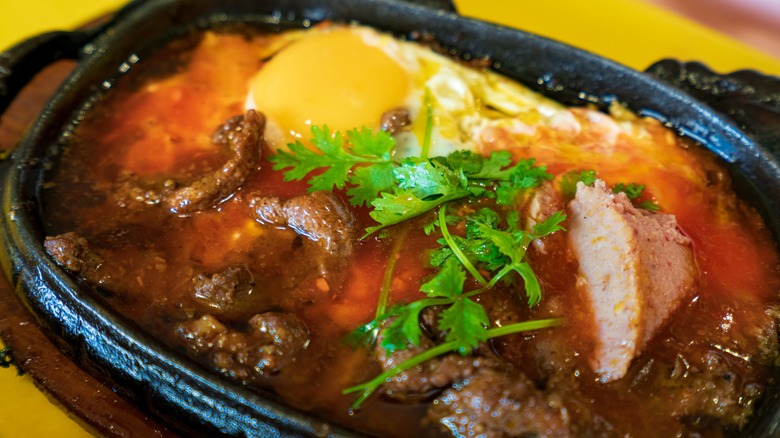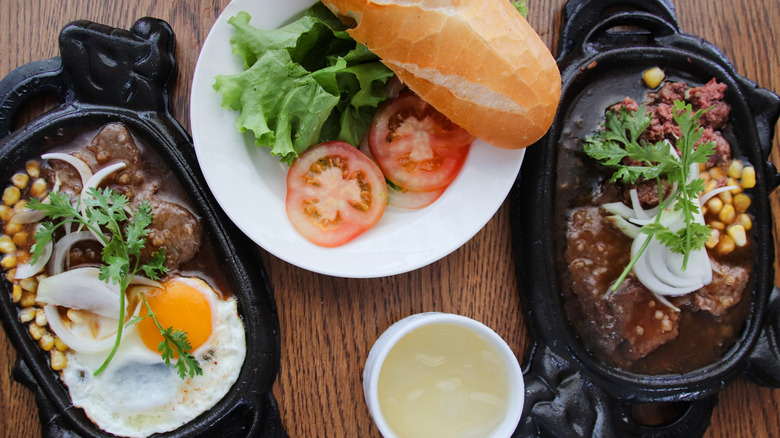Bò Né Is The Vietnamese Steak And Eggs Dish You Should Know
There's an undeniable allure to a platter of sizzling beef. Hot, crispy, and drenched in a flavorful sauce, it makes for a tasty meal any time of day. In Vietnam, a sizzling serving of steak and eggs is a popular breakfast meal.
Called bò né, the dish translates to "dodging beef". The name playfully refers to the actions diners take to avoid all the scorching juices. And the process of eating it is casual and fun. The dish includes a mouth-watering spread of sunny side up fried eggs, pâté, baguette, side salad, and a dipping sauce. Mixing all the components is a highlight of the process — there's a do-it-yourself freedom to how it comes together. Washed down with an iced coffee, it makes for a fun and satisfying meal. Popularly served at roadside stalls and other street food eateries, bò né utilizes high-heat techniques to generate big flavor. Let's dive into how it came about.
Bò né is a Vietnamese breakfast staple
As with other Vietnamese dishes, bò né merges a range of global culinary influences into a distinctly homegrown creation. It's believed to have started as a street food in the port city of Vũng Tàu, made as an affordable breakfast repurposing lesser beef cuts. Served on a sizzling plate, it's a dependable but appetizing food accessible to workers, students, and families.
While the dish's precise inspirations are unknown, many note its similarity to American-style steak and eggs breakfast. There's also a French influence through three of Bò né's components — the pâté, baguette, and butter. Now engrained into Vietnamese cuisine, such ingredients showcase the country's culinary history. Although it has some Western origins, bò né has become definitively a Vietnamese creation. Enjoyed around the country — as well as in Vietnamese restaurants abroad — it's an easy-to-love meal that will leave you feeling incredibly full.
Ingredients in bò né
As evident from the dish's name, beef is bò né's central component. Every vendor has their own preferred meat cut and preparation. The beef is marinated in a shifting array of components, with oyster sauce and black pepper being common additions, though some vendors don't marinate the beef at all.
To accompany the beef, vendors include pâté — pre-made or purchased — and sometimes sausage. Vegetables are also commonly griddled for added flavor, with varying additions including onions, shallots, or green onions, as well as garlic and small tomatoes. And to tie it all together, eggs and butter are bò né stalwarts. Plus, you can't neglect the loaf of baguette — used to sop up all of the tasty sauce and juices. Some vendors also serve a simple, refreshing side salad made of components like lettuce, tomatoes, and onions. Let's dive into how all these ingredients come together.
How to make bò né
Bò né starts with the marinade. Oyster sauce and black pepper are core components of the flavoring sauce; you may find variations with ingredients like soy sauce, hoisin, garlic, ginger, or chiles. Some pre-slice the beef, while other vendors cut the meat into slivers right before cooking. In some renditions, the steak is kept whole.
Next, the hot griddle — a cast iron sizzle platter reminiscent of a fajita dish — is heated over gas. The steak is thrown onto the burning hot surface and seared for a few minutes on each side. Depending on the cut of meat, it's usually cooked to approximately a medium to well-done consistency. It's then taken off to rest (or in some cases, left in the pan while the other ingredients are added).
Meanwhile, the onions, garlic, and other aromatics are added to the pan and caramelized in the excess marinade. Then come two eggs, cooked sunny side up, alongside a generous chunk of butter. Once ready, the meat is placed back onto the platter and garnished with a Vietnamese-style baguette as well as thick-cut pâté.
How bò né is served
Eateries serve bò né on red-hot platters alongside dipping sauces, condiments, and salads. Variations are abundant — restaurants offer their unique takes on toppings and accompaniments. Sauces can be from something simple like lime juice with black pepper to more complex flavored chile creations. The same applies to the toppings and sides, which range from Vietnamese sausage to cucumber, fries, and more.
Everyone has their own method of eating the dish. The bread can be dipped into the egg yolks, condiments, and juices. Or bò né can be turned into a makeshift sandwich with the meat stuffed into the baguette alongside the vegetables. There's no wrong way to do it; bò né restaurants are casual and enjoyed by people from all walks of life. In this accessibility lies their comfort — who doesn't want a flavorful, sizzling platter of beef enjoyed any time of day?




